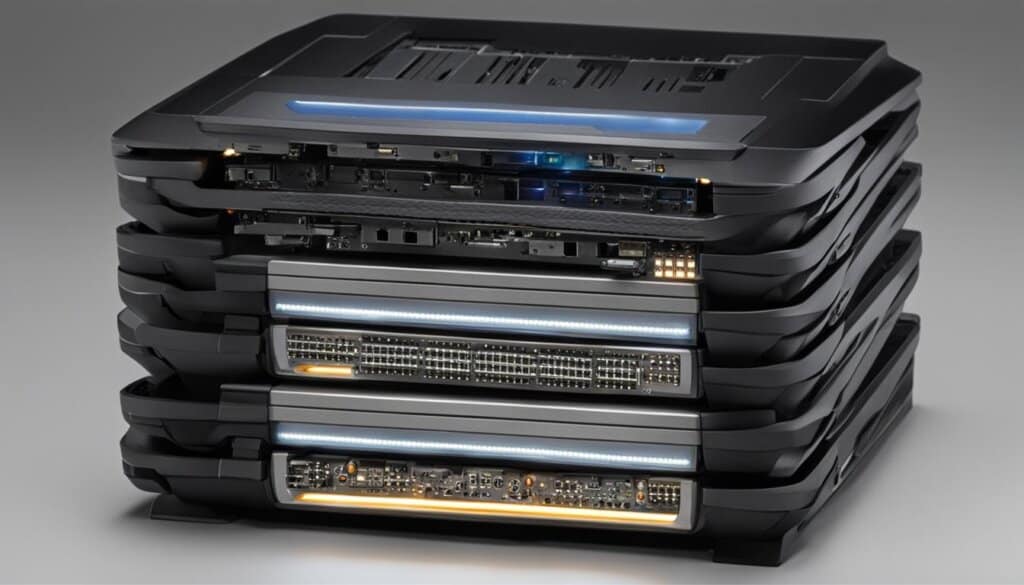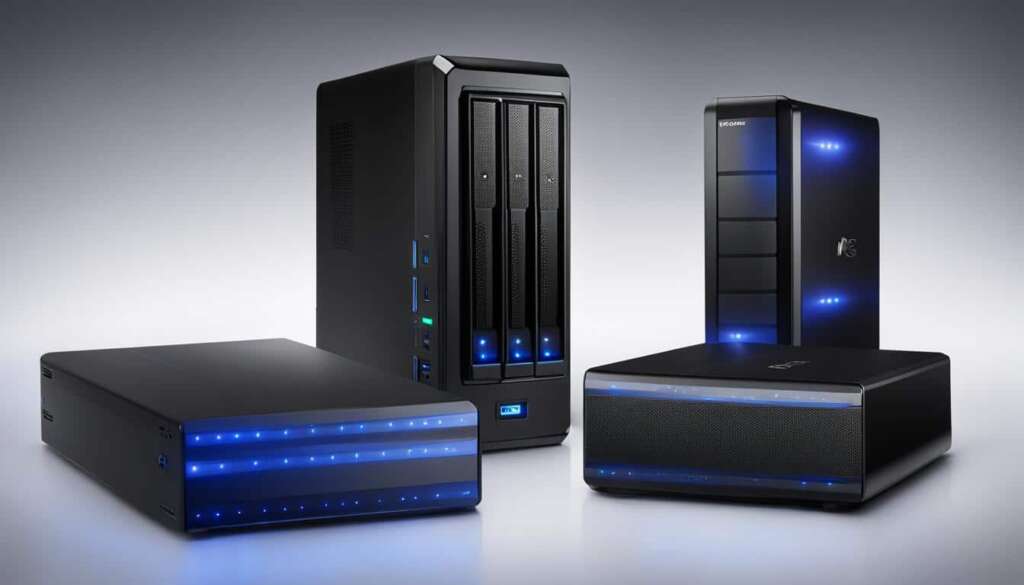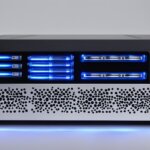Table of Contents
Network-attached storage (NAS) is a type of file storage that allows multiple users and devices to access and retrieve data from a centralized location. Unlike traditional storage systems that are directly connected to a single computer, NAS is accessed through a local area network (LAN) using a standard Ethernet connection.
NAS is widely used for its ease of access, high storage capacity, and cost-effectiveness. By consolidating storage in one place, it simplifies data sharing and collaboration among distributed teams. NAS also supports tasks such as data backup, archiving, and serving as a foundation for personal or private clouds.
In various industries, NAS finds its applications in diverse scenarios, including backup, hosting messaging and server-based applications, testing and developing applications, and serving email, multimedia files, databases, and print jobs. With its components like a CPU, network interface, storage drives, and operating system, NAS devices provide reliable and secure storage solutions.
When choosing a NAS, factors such as capacity, form factor, performance, connectivity, reliability, security, and usability should be considered to ensure the best fit for specific storage requirements and use cases.
What is Network-Attached Storage Used For?
Network-Attached Storage (NAS) is a versatile solution that serves various purposes in organizations. Let’s explore the different use cases where NAS can be utilized:
- File Storage and Sharing: NAS allows seamless storage and sharing of files across multiple users and devices in a centralized location.
- Active Data Archives: NAS facilitates the creation of active data archives, ensuring quick and efficient access to frequently-used files.
- Data Backup and Disaster Recovery: NAS serves as a reliable backup solution, providing secure storage for important data and enabling quick disaster recovery.
- Virtual Desktop Infrastructure (VDI) Hosting: NAS can host virtual desktops, providing a centralized and scalable solution for remote access to desktop environments.
- Web Applications: NAS can be used for testing and developing web applications, providing a dedicated environment for developers.
- Media Streaming: NAS enables smooth streaming of media files, such as videos, music, and torrents, ensuring uninterrupted entertainment.
- Image and Video Storage: NAS provides efficient storage for images and videos that require frequent access, making it ideal for photographers, videographers, and media companies.
- Printing Repository: NAS can serve as an internal printing repository, allowing users to send print jobs directly to the NAS device.
For example, a media company can leverage NAS to store and access a large collection of images for editing by their employees over the company network.
With its versatility and scalability, NAS proves to be an indispensable tool in modern organizations, catering to diverse storage needs and ensuring seamless data management.
Summary of NAS Uses
| Use Cases | Description |
|---|---|
| File Storage and Sharing | Allows storage and sharing of files across multiple users and devices |
| Active Data Archives | Facilitates quick access to frequently-used files |
| Data Backup and Disaster Recovery | Provides reliable backup and quick recovery of important data |
| Virtual Desktop Infrastructure (VDI) Hosting | Hosts virtual desktops for remote access to desktop environments |
| Web Applications | Testing and developing web applications in a dedicated environment |
| Media Streaming | Enables smooth streaming of media files |
| Image and Video Storage | Efficient storage for frequently-accessed images and videos |
| Printing Repository | Serves as an internal printing repository for print jobs |
Components of a NAS Device
A Network-Attached Storage (NAS) device is composed of various components that work together to provide efficient and reliable storage solutions. These components include:
1. Physical Storage Drives
NAS devices are equipped with multiple physical storage drives, typically ranging from two to five drives. These drives offer high-volume storage capacity, allowing users to store and access large amounts of data. To optimize performance and ensure data redundancy, these drives are organized logically using RAID (Redundant Array of Independent Disks).
2. CPU
The NAS device is powered by a CPU (Central Processing Unit) that runs the NAS operating system and handles data processing tasks. The CPU plays a crucial role in managing user access, ensuring smooth data transfers, and maintaining overall system performance.
3. Operating System
An operating system controls and manages the hardware components of the NAS device. It provides a user-friendly interface and allows clients to access and manage the stored data. The operating system also ensures the availability of storage to connected devices and facilitates data security measures.
4. Networking Interface
The networking interface of a NAS device enables connectivity to the local area network (LAN) or Wi-Fi. It establishes a connection between the NAS device and the network, allowing users to access the stored data from multiple devices. The Ethernet cable or Wi-Fi connection provides seamless data transfer and ensures reliable network connectivity.

| Component | Description |
|---|---|
| Physical Storage Drives | High-volume storage drives with RAID for data organization and redundancy. |
| CPU | Central Processing Unit responsible for running the NAS operating system and data processing. |
| Operating System | Manages the NAS hardware, provides a user interface, and ensures data availability and security. |
| Networking Interface | Enables connectivity between the NAS device and the network for data access and transfer. |
How NAS Works and Its Comparison with Other Storage Architectures
In the world of modern data storage, Network-Attached Storage (NAS) plays a vital role in facilitating efficient communication and data management. NAS functions by utilizing communication protocols like IP and TCP to transfer data over a network. These protocols ensure seamless connectivity and enable users to access and retrieve their files from a centralized location with ease.
For compatibility with various operating systems, NAS employs different file formatting protocols such as NFS, SMB, and AFP. These protocols allow NAS to interact seamlessly with different platforms and ensure smooth file sharing and data access.
When comparing NAS with other storage architectures like Storage Area Networks (SAN) and Direct-Attached Storage (DAS), it is important to understand the key differences. While SAN is a dedicated high-speed network that interconnects servers and storage devices, DAS directly attaches storage to a single server.
NAS provides file-level access, meaning that users can access and manage files directly, making it suitable for environments where file sharing and collaboration are essential. SAN, on the other hand, focuses on block-level access, making it ideal for applications that require high-performance and low latency, such as databases and virtual machines. Each storage architecture, whether NAS, SAN, or DAS, has its own advantages and is suited for different use cases based on the specific storage and data management requirements.
FAQ
What is NAS storage?
Network-attached storage (NAS) is a dedicated file storage solution that allows multiple users and devices to access data from a centralized location over a local area network (LAN).
What is NAS used for?
NAS is used for various purposes such as file storage and sharing, creating active data archives, performing data backup and disaster recovery, hosting virtual desktop infrastructure, testing and developing web applications, streaming media files, storing images and videos, and creating internal printing repositories.
What components does a NAS device consist of?
NAS devices consist of physical storage drives, a CPU, an operating system, and a networking interface.
How does NAS work and how does it compare to other storage architectures?
NAS functions by utilizing communication protocols like IP and TCP to transfer data over a network. It uses file formatting protocols such as NFS, SMB, and AFP for compatibility with different operating systems. NAS is compared to other storage architectures such as SAN and DAS, with NAS providing file-level access and easy data access.













